Issue 16, September 19, 2011
Is Your Hosta Hosting Hostile Pathogens?
The hosta is a popular landscaping plant, loved for its beautiful variety of foliage, and ease of cultivation. Around this time, delicate purple or white flowers develop before frost. Below are some of the most prevalent pathogens on hosta in Illinois.
Foliar nematodes
Hosta can be susceptible to foliar nematodes (Aphelenchoides spp). These microscopic worms can infect the above-ground parts. They are able to swim through a film of water on the leaf surface of a hosta and then enter plant tissue via natural openings or wounds. Foliar nematodes that infect hosta is able to spread to plant tissue in drops of splashing water or by way of gardening tools. Symptoms of these foliar nematodes start out as water-soaked areas within parallel veins on leaves, but later these long areas can become necrotic, dark, and maybe even tattered in appearance. To control foliar nematodes remove infected leaves, reduce overhead irrigation, and sanitize garden tools.
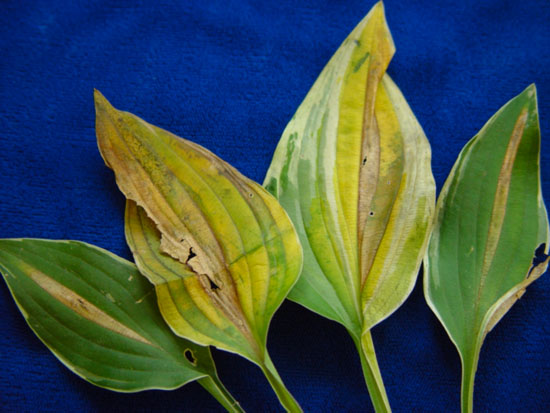
Hosta leaves infected with foliar nematodes and showing the common symptom of interveinal brown bands. Photo credit University of Illinois Plant Clinic.
Petiole Rot
Petiole rot on hosta is caused by the fungus Sclerotium rolfsii. This disease usually kills the plant quickly by rotting the base of the petioles. Fungal structures of Sclerotium rolfsii can be found on the soil surface or near the crown of the hosta. If a hosta becomes infected with petiole rot, leaves can turn yellow, collapse, and can easily be pulled from the ground. Often times, the base of the petiole is covered in white, thread-like mycelium and small, round, tan to brown structures may be visible. These structures are sclerotia, which are resting structures of this fungus, that can provide a way of overwintering. Sclerotium rolfsii can be spread to other plants when the sclerotia are moved from one area to another on shoes, garden equipment, and plant material. Because the fungus can overwinter for years in the soil, it can be very difficult to control. Destroying infected plants, removing infested soil, and using preventative fungicides will offer some control of this disease.
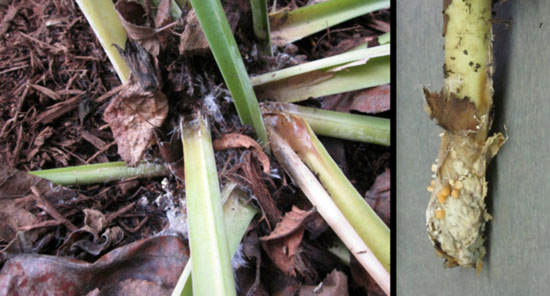
Left: Collapsed hosta petioles are covered in white mycelium of Sclerotium rolfsii at the base. Right: Base of infected hosta petiole with the small, round, tan to brown sclerotia of Sclerotium rolfsii. Photo credit Diane Plewa.
Hosta Virus X
Hosta Virus X (also known as HVX) is a virus which causes mosaic, yellowing, and necrosis on the foliage of hosta plants. Once a hosta is infected, this virus can lurk within infected plant sap, and can easily be spread by hands and garden tools. HVX can also persist in plants for years before symptoms develop, and any plants propagated from an infected plant will also develop the disease. Buying plants from reputable sources, destroying symptomatic plants, and sanitizing equipment are the only means of control for the Host Virus X.
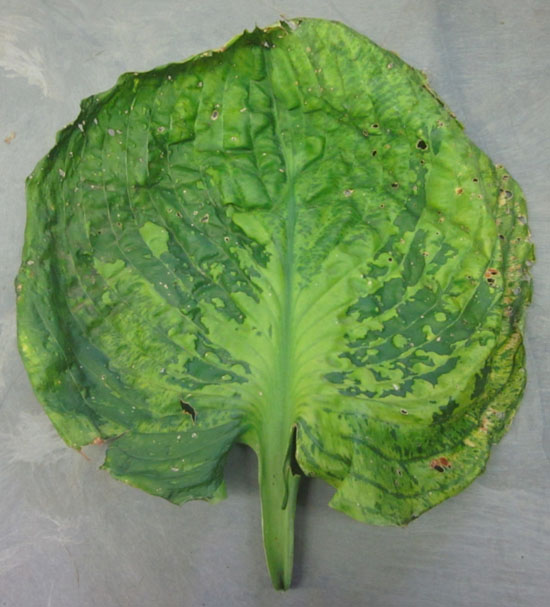
A hosta leaf infected with HVX and showing dark mottling symptoms. Photo credit Diane Plewa.
Leaf Spots
Leaf spots are common to hosta. While they make plants less attractive, they rarely are considered to be serious disease; although they can contribute to overall plant stress. There are many different fungi that cause foliar spots on hosta. Control methods for all of the hosta leaf spot diseases are similar, regardless of the fungal, causal pathogen and area as follows: overhead irrigation should be avoided, heavily infected leaves removed, and garden equipment sanitized. Protective fungicides can be applied before the disease infection takes place. These chemicals are especially useful for plants that were previously affected by fungal leaf spots in the past.
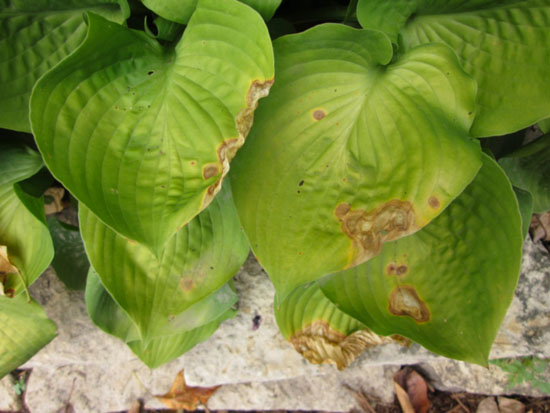
Fungal leaf spots on hosta. Photo credit Diane Plewa.
Abiotic Problems
Like all plants, hosta is susceptible to sunscald and drought stress. Slugs can also be a major pest of hosta. Hosta plants prefer moist, well-drained soils. Depending on the variety, they will do well in a range of full shade to full sun (though most favor partial shade). Stressed plants tend to develop diseases more frequently than unstressed ones, so reducing stress and increasing plant vitality can be a powerful tool to prevent disease development in your garden.
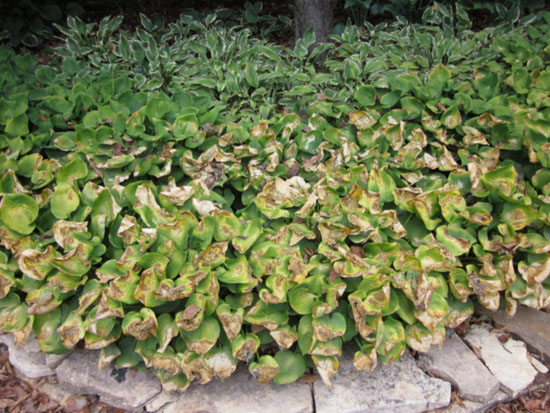
A bed of hostas stressed by sunscald and disease. Photo credit Diane Plewa.
(Diane Plewa)
Author:
Diane Plewa